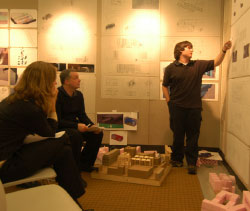
In a high-cost of living region like San Diego, not all jobs are equally attractive, nor do all justify an intentional strategy for growth. A design+technology jobs cluster, including firms in both sectors, is the ideal target for a focused and vigorous economic development initiative. This cluster combines the two highest paying industries in San Diego and has potential for significant growth as evidenced by the performance of the technology, digital and media- related design businesses over the past several years.
The Context
As we stated in section one, San Diego has amazing weather, is home to the busiest international border in the world and has strong job clusters in telecommunications, biomedical, tourism, clean tech and the military. It does not however, enjoy the competitive advantage of being an established gateway city for the 21st century. Gateway cities, as the name implies, are those markets that typically have deep-water ports, easy rail access, international/hub airports, major medical centers, university complexes and multiple industry clusters. Examples include San Francisco, Seattle, Los Angeles, New York and Boston. As a result, the leadership of San Diego has to be more strategic, deliberate and innovative to grow the local economy and maintain the quality of life we have come to enjoy.
“San Diego, along with the rest of California, is showing stronger economic growth than the rest of the nation the past two years. This is largely due to the stirrings of innovative sectors driving new economic activity.”
The Fight for High-paying Jobs Is On
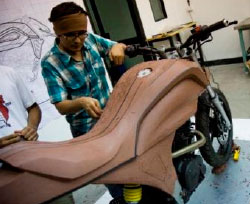
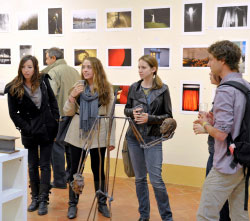
All cities are searching for the next new industry that will grow high-paying jobs. The US Department of Labor estimates that 70% of jobs in 2020 do not exist today, because the new technologies that define these new jobs have yet to be invented. According to the publication entitled “Strategic Blueprint for the DesignSingapore Initiative,” “it is now commonly accepted that everyone can expect to have three to four significant career changes in a lifetime. This has a profound implication on education. But more importantly this rate of change will need to be matched with a new mindset…It is no longer business as usual. We are facing increasing competition in the new ideas-driven creative economy.”1
What are the new “idea-driven” industries and businesses that would thrive as a result of San Diego’s unique physical, cultural and location attributes, and would produce the kinds of jobs that can support a household?
This question is very much of the moment. The recently completed Our Greater San Diego Regional Visioning Initiative sponsored by The San Diego Foundation was an effort to identify those issues most important to San Diegans as they look to 2050 and beyond. Findings from the initial research phase identified two matters that are of the greatest concern to San Diegans:
- The high cost of living in the region. Respondents expressed great concern about whether their kids could afford to stay here;
- The lack of availability of high-paying jobs.
The pressure is on to develop a winning strategy – SANDAG projects that the region will need to create 500,000 jobs by 2050 to support a projected population increase of 1.4 million people.2
Everyone agrees that we must aggressively and intentionally grow jobs to expand our economy, but what kind of jobs and how do we grow them? The potential for growth from existing, mature jobs clusters in our region in traditional industries is flat. Current share of San Diego employment sectors include: government 15.6% (weighted by presence of multiple military branches/bases), professional and business jobs 13.7%, and leisure and hospitality industry at 10.6%.3
The technology sector, including pharma/bio/medical, software, communications, computers and electronics, clearly presents one of the best opportunities for growth. According to the latest CONNECT Innovation Report Q1 2012 (released October 2012), the Technology/ Innovation/Manufacturing cluster, which accounts for 6% of the companies and nearly 140,000 jobs in the region, saw modest job growth over the past several years. However, they outperformed the rest of the San Diego economy and expect job growth to pick up this year as the general economy strengthens.
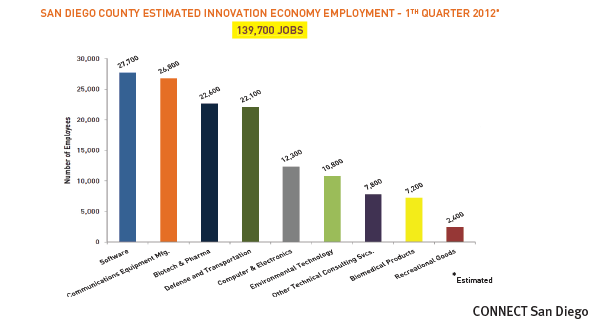
This cluster creates the highest paying jobs in the region – averaging over $94, 000 – so the 11% of the workforce in this sector comprises over 20% of all wages in the region.4 Design related jobs pay, on average $76,000, which is second only to telecommunications and technology.5
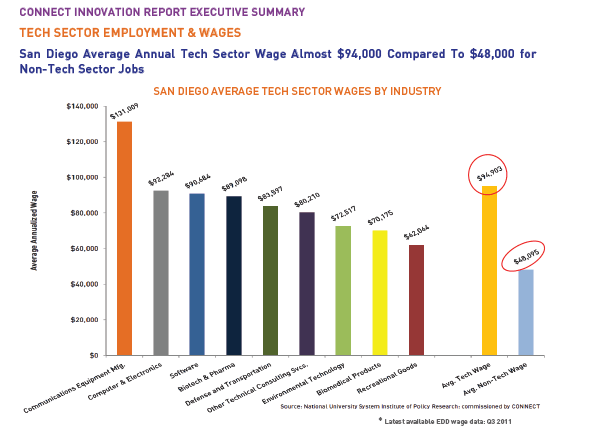
While leisure and hospitality jobs (at an average of $21,000 annually) are valuable as initial steps on the prosperity ladder, but are not by themselves going to fulfill San Diego’s need for high-paying jobs in the ideas-driven creative economy.
Indeed, the recovery from the very steep downturn in 2008 and 2009 is well underway and San Diego has now returned to a growth path of new technology businesses, new technology jobs, and increases in venture capital funding. The graphs tell the story of how innovation companies, led by communication equipment manufacturing, software, defense and transportation, and biotechnology and pharmaceutical, are generating high-paying jobs that bring significant additional spending into our communities.
Insights We Gained from Our Research:
- Validation that design-based services are a growth sector, producing attractive jobs.
- Other nations have already begun investing in the infrastructure needed to attract designers and design firms.
- Other cities in the US have similarly begun to focus on attracting design jobs and have already begun to benefit.
Design — A Natural Technology Partner
Currently design activity accounts for approximately 18,500 jobs across 16 disciplines in San Diego. This represents a fairly small segment of the overall economy, but it is quite rich in diversity. From golf and action sports to car and product design to digital gaming and 3-D animation to furniture and fashion—there are a variety of entrepreneurial and established firms working throughout the region with little geographic focus. San Diego’s various design firms are spread across the wide reach of the overall county. Though some natural clustering has occurred, it is typically on a minor scale and in very few instances reaches across multiple disciplines.
Looking to grow these industries, what are the physical, cultural and location attributes most attractive to design firms? That is what we wanted to learn by speaking with designers working in a variety of fields. We wanted to know how proximity to customers, the natural and built environment, high-quality amenities, an educational pipeline, and cost of living factor into their decision-making process. In a nutshell, San Diego already ranks very high along many of these dimensions with the potential for improvement.
Observations from San Diego’s Creative Class
“San Diego iS the perfect city to wed technology and design.”
Gad Shaanan
CEO, Gad Light
We met with nine firms representing a variety of design disciplines for in-depth interviews, office tours and follow-up conversations. The fields represented include graphic design, industrial design, video gaming, experience design, architecture and automotive design.
Key Takeaways
- They are attracted to the concept of co-location – San Diego currently lacks a suitable co-location place
- Designers want to be celebrated and recognized
- They don’t want a glossy, “master-planned” environment
- Designers want to have a hand in creating the District – that’s what they do
- They would rather occupy buildings with a diverse mix of design firms and artists
- The sociology is as important as the built environment
- They value public transportation, proximity to the border and the East Village location
- Watering holes, music, performance art, street art – it’s about creating an experience that does not exist anywhere else
- It should not be about “can I afford it?” but about “I have to be there”
- They value the presence of schools and lots of students, which is why the NewSchool of Architecture and Design is an important anchor to the District
- Park and ample community gathering space is a must
- Sustainability is critical to this group
Participating Firms
Gad Light / Gad Shaanan, Principal / Industrial Design / La Jolla / Bennett Peji Design/ Bennett Peji, Principal/ Branding & Graphic Design / Downtown
Bulldog Drummond/ Shawn Parr, Principal / Marketing & Advertising / Bankers Hill
Sharp Experience / Mark Tomaszewicz, Director / HealthCare Experience / S.D.
Starizon / Gary Adamson, Principal / Experience Design / Colorado
Greenhaus/Craig Fuller, Principal/Marketing & Branding/Bankers Hill
The Behemoth/John Baez, President/ Video Game Design/Little Italy
Rob Quigley Architects/Rob Quigley, Principal/Architecture and Urban Design/ East Village / Jerry Hirschberg/Former head of the Nissan Design Studio/La Jolla
To learn more about the 5 Components of Design at the Intersection click here.
Endnotes
- DSG II – Strategic Blueprint of the DesignSingapore Initiative, Pg. 8 ↩
- SANDAG ↩
- http://www.sandiegobusiness.org/media/docs/data_demographics/8_4_07wageratebyindustry.pdf ↩
- CONNECT San Diego, Innovation Report, Q.4 2010 ↩
- Creative Vitality Index – Economic Data Provided by Economic Modeling Specialists, Inc. ↩